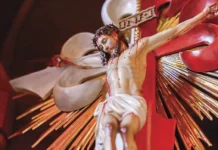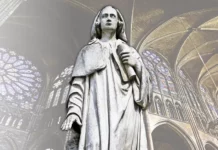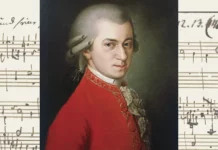Among the elements that make up Eucharistic spirituality are charity, devotion to Jesus in the Blessed Sacrament and the beauty of the Liturgy, which is not a mere adornment but rather part of the essence of the celebration of the Eucharist.
Before all else, I wish to greet Cardinal Raymundo Damasceno Assis. We were colleagues in Rome and have always maintained a friendship and collaboration. He did not invite me for this lecture, but ordered me! And I came with great joy. I also greet my brother bishops here present and Msgr. Antonio Luiz Catelan Ferreira, a great theologian, who was my student at the Faculty of Theology in São Paulo.
At this moment I would also like to greet Msgr. João Scognamiglio Clá Dias, founder of the Heralds of the Gospel, who continues, with his life of holiness and prayer, to sustain this great organization and glory of the Church.
Let us now enter upon the theme of our reflection: Eucharistic spirituality.
The Eucharist, great salvific event
Immediately following the Consecration of the bread and wine, the celebrant exclaims, “The mystery of Faith!” According to Pope St. John Paul II, in the Encyclical Ecclesia de Eucharistia, and Pope Benedict XVI, in the Post-Synodal Apostolic Exhortation Sacramentum caritatis, this is not a simple exclamation, but a proclamation full of enthusiasm and elation, almost an ecstasy. Such enthusiasm is in reality an echo of that which the Apostles experienced at the Last Supper, when they heard Christ’s command: “Do this in memory of Me” (1 Cor 11:24). They would never have had the audacity to repeat the solemn words of Jesus instituting the Eucharist if they had not received this command. […]
“The mystery of Faith!” Mystery is a salvific event revealed by God Himself. And the Eucharist, as the memorial of the redemptive Sacrifice of Calvary, is the greatest mystery, the greatest salvific event revealed by God. It reminds us that Faith does not consist primarily in adherence to a doctrine, but in the acceptance of a salvific event. […]
Salvation history unfolds in space and time. It began immediately after the sin committed at the origins of humanity, when God said to the Serpent, the image of the devil: “I will put enmities between thee and the Woman, and thy seed and her seed: She shall crush thy head” (Gn 3:15); it had its culmination in the “fullness of the time” (Gal 4:4), as St. Paul teaches, at the moment of the Incarnation, when the Son of God became Man; and it will have an end: the glorious return of Christ to deliver to the Father the humanity redeemed by Him on the Cross and resurrected.
However, after the Lord’s Ascension into Heaven, salvation history continues in a sacramental way. And the principal Sacrament is the Eucharist, which St. Thomas Aquinas calls “tantum ergo sacramentum”, great Sacrament, great mystery, great salvific event. […]
Principal act of the Church’s foundation
I would like to recall the title of the Encyclical Ecclesia de Eucharistia – The Church draws her life from the Eucharist – by which St. John Paul II shows that the institution of the Eucharist was the principal act of the Church’s foundation.
There were various foundational acts of the Church. It is enough to recall the convocation of the Twelve Apostles. The people of Israel, God’s people of antiquity, were made up of twelve tribes, descendants of the twelve sons of the patriarch Jacob. By calling twelve Apostles, Christ showed that He was founding the new Israel, the new people of God. Therefore, the number twelve became sacred. Because of Judas’ death, the first action the Apostles took after the Ascension was to re-establish the number twelve in the Apostolic College, with the choice of Matthias.
We can say that the institution of the Lord’s Prayer, the Our Father, which Christ transmitted to His disciples, was also a foundational act of the Church. At that time, each religious group in Israel – that of the Pharisees, the Sadducees, and John the Baptist – had its own prayer. An interesting fact: it was the prayer that gave the group its identity. So, by giving the community of His disciples their own prayer, Jesus gave it an identity before the other religious groups of Israel.
However, the main act of the foundation of the Church was the institution of the Eucharist, in which the paschal lamb was replaced by the Body of Christ, and the chalice of the Old Covenant by that of the New Covenant. Just as Israel became God’s people through the covenant on Sinai, Christ, in making the New Covenant through the institution of the Eucharist, founded the New Israel, which is the Church.
Ecclesia de Eucharistia signifies what the Church does, celebrates the Eucharist; it is the principal act that she performs, through her ordained ministers. But it also means that the Eucharist illuminates the whole life of the Church: catechesis, morality, mission, and so on. […]
The Church becomes fully the Body of Christ in the celebration of the Eucharist

Ecclesial communion is not a voluntary effort on our part. It is first of all communion in grace, the communion of Saints – of those who have been sanctified through Baptism –, communion with Christ. That is why St. Paul clearly shows that the Church becomes fully the Body of Christ in the celebration of the Eucharist.
In a sense, he defends the following thesis. When I eat a piece of bread, it becomes my body; when I drink a cup of wine, it becomes my blood. So eating and drinking are acts of communion (cf. 1 Cor 10:16-17).
From this, Paul draws some consequences: those who eat meat offered in sacrifice – he refers to the Jewish cult – enter into communion with the altar, with the sacred; those who eat meat offered to idols enter into communion with demons, because idols are works of demons; and those who eat the Eucharist enter into communion with the Body of the Lord. It is in the celebration of the Eucharist, then, that the Church becomes fully the Body of Christ. The Eucharist expresses the identity of the Church, and every time the Church celebrates it, she grows in communion. […]
Centre of Christian life
We now turn to Eucharistic spirituality, the theme of this reflection. […] Spirituality consists in living in relationship with God, in communion with God. Now in this world there is no fuller way of being in communion with God than the Eucharist. It is the centre of the Christian life, and Eucharistic piety is Christian spirituality. Therefore, any other spirituality must be linked to the Eucharist, otherwise it will not be authentic.
From this premise I wish to demonstrate some consequences.
First of all, a component of Eucharistic spirituality is our life transformed into worship pleasing to God. St. Paul says in the Letter to the Romans: “I appeal to you therefore, brethren, by the mercies of God, to present your bodies as a living sacrifice, holy and acceptable to God, which is your spiritual worship” (12:1). For Paul the body means the whole human being, including its visibility. And to designate worship, he speaks of liturgy: “Brothers, I ask you to offer your bodies as a liturgy pleasing to God.” So, the life of the one who has Eucharistic spirituality becomes that liturgy pleasing to God.
Sacrament of charity
Another component of Eucharistic spirituality is charity. We can say that the Eucharist is the Sacrament of charity, the Sacrament of the new commandment: “A new commandment I give to you, that you love one another; even as I have loved you, that you also love one another” (Jn 13:34). It is no longer a matter of loving one’s neighbour as oneself, but of going further: of loving one’s neighbour like Christ, in the manner of Christ.
St. Augustine1 affirms that whoever lives the new commandment of love becomes a new creature. This new commandment is so important that the Christians of the apostolic age invented a technical term to designate it: agape, which we translate as charity.
Charity is first of all a crucified love, capable of suffering and dying for one’s neighbour, as Jesus did. Charity is a self-giving love. It does not consist only in giving something to one’s neighbour – food, for example – but in giving oneself, each day spending a little of one’s life so that the other may have more life. Charity is a love full of hope.
For those who have charity, no one is beyond recovery, no one is definitively lost; a person can become a new creature even at the moment of death. And finally, charity is the love that forgives everything.
What does it mean to forgive? To forgive is not just to forget the fault or to be indifferent to it, but to heal the wound of the fault. Every fault is an open wound in truth and love. Every fault offends God, because God is Truth, God is Love. Now, through the love of charity, in which we unite our forgiveness to Christ’s forgiveness, the wound of the fault is healed. […]
The devotion most pleasing to God and most useful for us
Yet another component of Eucharistic spirituality is what we may call the cult of the Eucharist. The Real Presence of Christ continues in the species of bread and wine even after Mass, and from this arises the worship of the Eucharist, expressed in the various forms of adoration.
St. Alphonsus de Liguori states: “To adore Jesus in the Blessed Sacrament is, after the Sacraments, the first among all devotions, the one most pleasing to God and the one most useful to us.”2 Adoration of the Eucharist takes place at holy hours, at Benedictions with the Blessed Sacrament, in Perpetual Adoration, in Eucharistic processions, in visits to Jesus in the Blessed Sacrament. My mother visited Him every day.
St. Augustine wrote, already in his time: no one should approach the Eucharist without first adoring Him.3 Adoration of the Eucharist, then, makes us participate more deeply in the Eucharistic Celebration.
The beauty of the Liturgy is not merely an adornment
Another element in Eucharistic spirituality is the beauty of the Liturgy. Pope Benedict XVI4 says that the beauty of the Liturgy is not an adornment, but rather it belongs to the essence of the Liturgy, especially the Eucharistic Liturgy.
Note well that, as St. Luke shows, the Eucharist was instituted by Jesus’ will in the upper room of the house, furnished with cushions (cf. Lk 22:12). It was a beautiful room! At the beginning of the third century, Christians began to build temples that were architecturally beautiful. Why? Because the Eucharist was to be celebrated there. Accordingly, not only the soul of those who participate in the Eucharist ought to be, by the state of grace, beautiful, but so also the temple in which it is celebrated.
Beauty belongs, therefore, to the celebration of the Eucharist. And this is why nothing can be changed in the celebration of the Eucharist. No one owns the Eucharist; it is a patrimony of the Church.
Indeed, the Church, when she wants to make a very small change in the Liturgy, takes great care and first verifies that the proposed modification is in accordance with Christian Tradition and the doctrine of the Magisterium. […]
The Heralds evangelize, above all, through the beauty of holiness
I wish to close my presentation by referring now to the theme of this symposium: the charism of the Heralds. This charism is expressed in the very name of the institution: Heralds of the Gospel. Proclaimers! People who proclaim the Gospel aloud, with conviction. In the case of the Heralds, however, this proclamation has a very important detail: they evangelize by means of the via pulchritudinis, as St. Augustine said, by the way of beauty.
The Heralds evangelize through the beauty of the Liturgy, which they cultivate. They evangelize through the beauty of music, especially Gregorian chant. This is the liturgical chant par excellence, the chant that elevates us to God through its melodies. And how they sing! The Heralds also evangelize through the beauty of their churches. They are not rich churches, but beautiful churches.
However, I would say that the Heralds evangelize, above all, through the beauty of holiness. They nurture holiness with great care, and holiness is beautiful. The beauty of God, infinitely removed from all evil and sin, is found, first of all, in His holiness. So it is through the beauty of holiness of life that the Heralds evangelize. For this reason, they are a patrimony that the Church must guard with great care and must also love. ◊
Excerpts from the conference given
at the symposium on the charism of the Heralds of the Gospel,
on 4/8/2021, in São Paulo – Any imprecision that may be found
is due to the spoken language in which it was delivered.
Notes
1 Cf. ST. AUGUSTINE. Tratados sobre o Evangelho de São João. Tratado LXV, n.1
2 ST. ALPHONSUS MARIA LIGUORI. Visite al Santissimo Sacramento ed a Maria Santissima. Introduzione. In: Opere ascetiche. Roma: CSSR, 1939, v.IV, p.295.
3 Cf. ST. AUGUSTINE. Comentários aos Salmos. Salmo XCVIII, n.9.
3 Cf. BENEDICT XVI. Sacramentum caritatis, n.35.











